Brand Management Report: Starbucks & Coca-Cola Brand Analysis
VerifiedAdded on 2020/12/10
|16
|5487
|230
Report
AI Summary
This report delves into the intricacies of brand management, utilizing Starbucks and Coca-Cola as illustrative examples. The introduction defines brand management and its significance, emphasizing its role in driving sales and building brand value. Task 1 examines how Starbucks has built and managed its brand over time, focusing on the CBBE model (Customer-Based Brand Equity) and brand extension strategies, including the introduction of refresher drinks and other product lines. Task 2 analyzes Coca-Cola's brand portfolio strategy, highlighting its consumer-centric approach and the hybrid brand model used for hierarchy management. This section explores how Coca-Cola manages its brand equity through various strategies. The report also analyzes the strengths and weaknesses of the brands and provides suggestions for improvement. Finally, the report concludes by summarizing key findings and emphasizing the importance of effective brand management for long-term success. The report is a valuable resource for students studying marketing and brand management, available on Desklib, a platform offering study tools and resources.
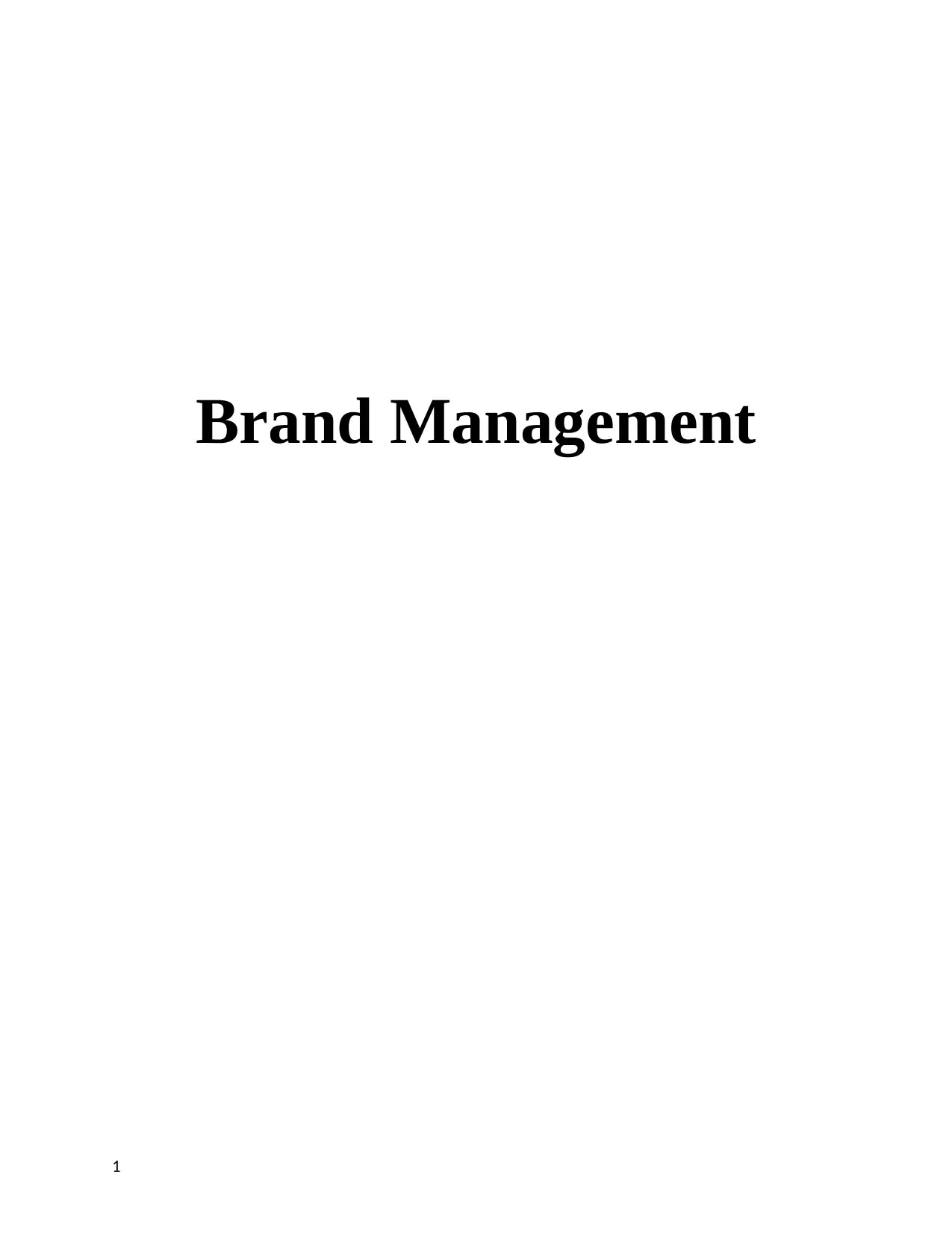
Brand Management
1
1
Paraphrase This Document
Need a fresh take? Get an instant paraphrase of this document with our AI Paraphraser
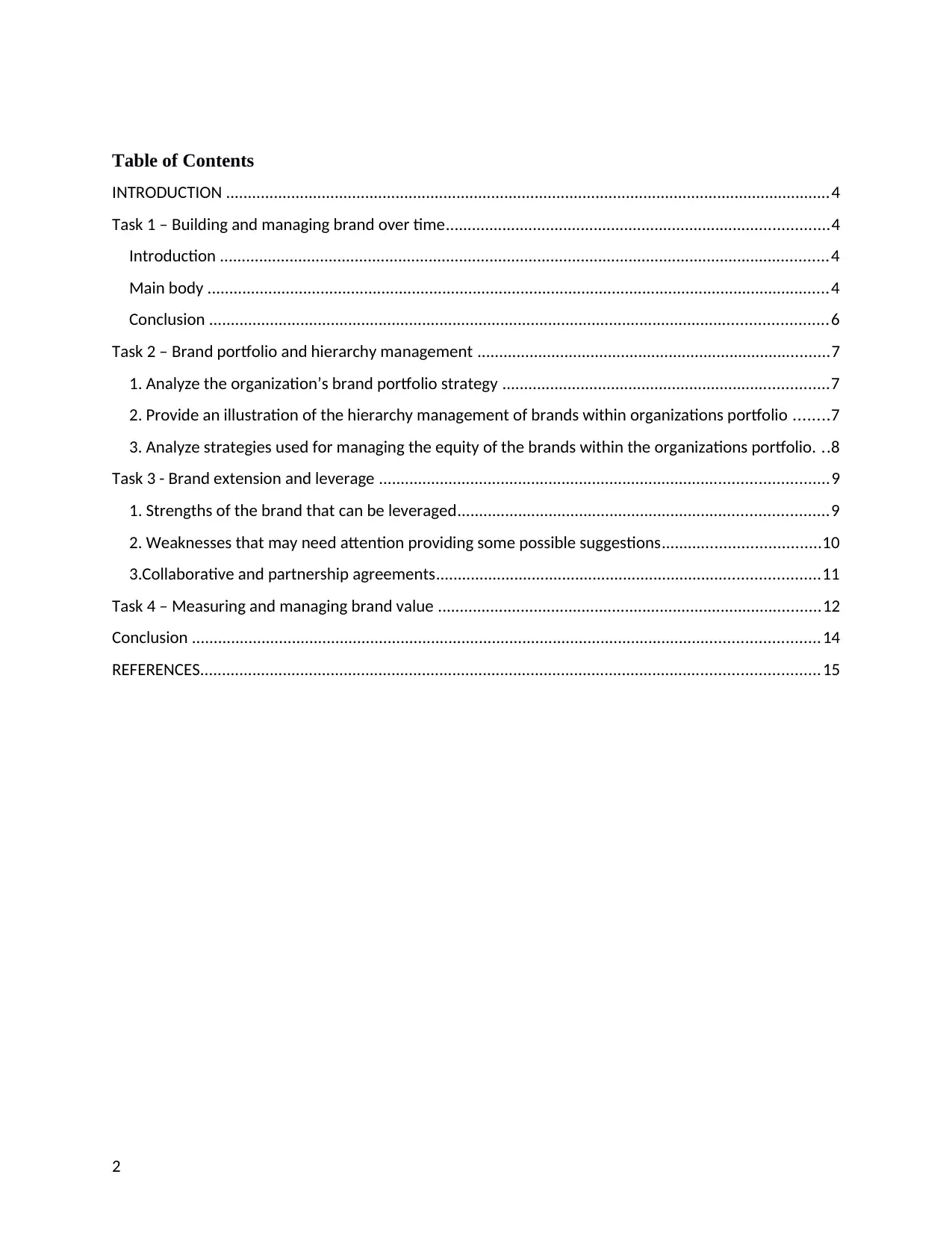
Table of Contents
INTRODUCTION ...........................................................................................................................................4
Task 1 – Building and managing brand over time........................................................................................4
Introduction ............................................................................................................................................4
Main body ...............................................................................................................................................4
Conclusion ..............................................................................................................................................6
Task 2 – Brand portfolio and hierarchy management .................................................................................7
1. Analyze the organization’s brand portfolio strategy ...........................................................................7
2. Provide an illustration of the hierarchy management of brands within organizations portfolio ........7
3. Analyze strategies used for managing the equity of the brands within the organizations portfolio. ..8
Task 3 - Brand extension and leverage .......................................................................................................9
1. Strengths of the brand that can be leveraged.....................................................................................9
2. Weaknesses that may need attention providing some possible suggestions....................................10
3.Collaborative and partnership agreements........................................................................................11
Task 4 – Measuring and managing brand value ........................................................................................12
Conclusion ................................................................................................................................................14
REFERENCES..............................................................................................................................................15
2
INTRODUCTION ...........................................................................................................................................4
Task 1 – Building and managing brand over time........................................................................................4
Introduction ............................................................................................................................................4
Main body ...............................................................................................................................................4
Conclusion ..............................................................................................................................................6
Task 2 – Brand portfolio and hierarchy management .................................................................................7
1. Analyze the organization’s brand portfolio strategy ...........................................................................7
2. Provide an illustration of the hierarchy management of brands within organizations portfolio ........7
3. Analyze strategies used for managing the equity of the brands within the organizations portfolio. ..8
Task 3 - Brand extension and leverage .......................................................................................................9
1. Strengths of the brand that can be leveraged.....................................................................................9
2. Weaknesses that may need attention providing some possible suggestions....................................10
3.Collaborative and partnership agreements........................................................................................11
Task 4 – Measuring and managing brand value ........................................................................................12
Conclusion ................................................................................................................................................14
REFERENCES..............................................................................................................................................15
2

3
⊘ This is a preview!⊘
Do you want full access?
Subscribe today to unlock all pages.

Trusted by 1+ million students worldwide
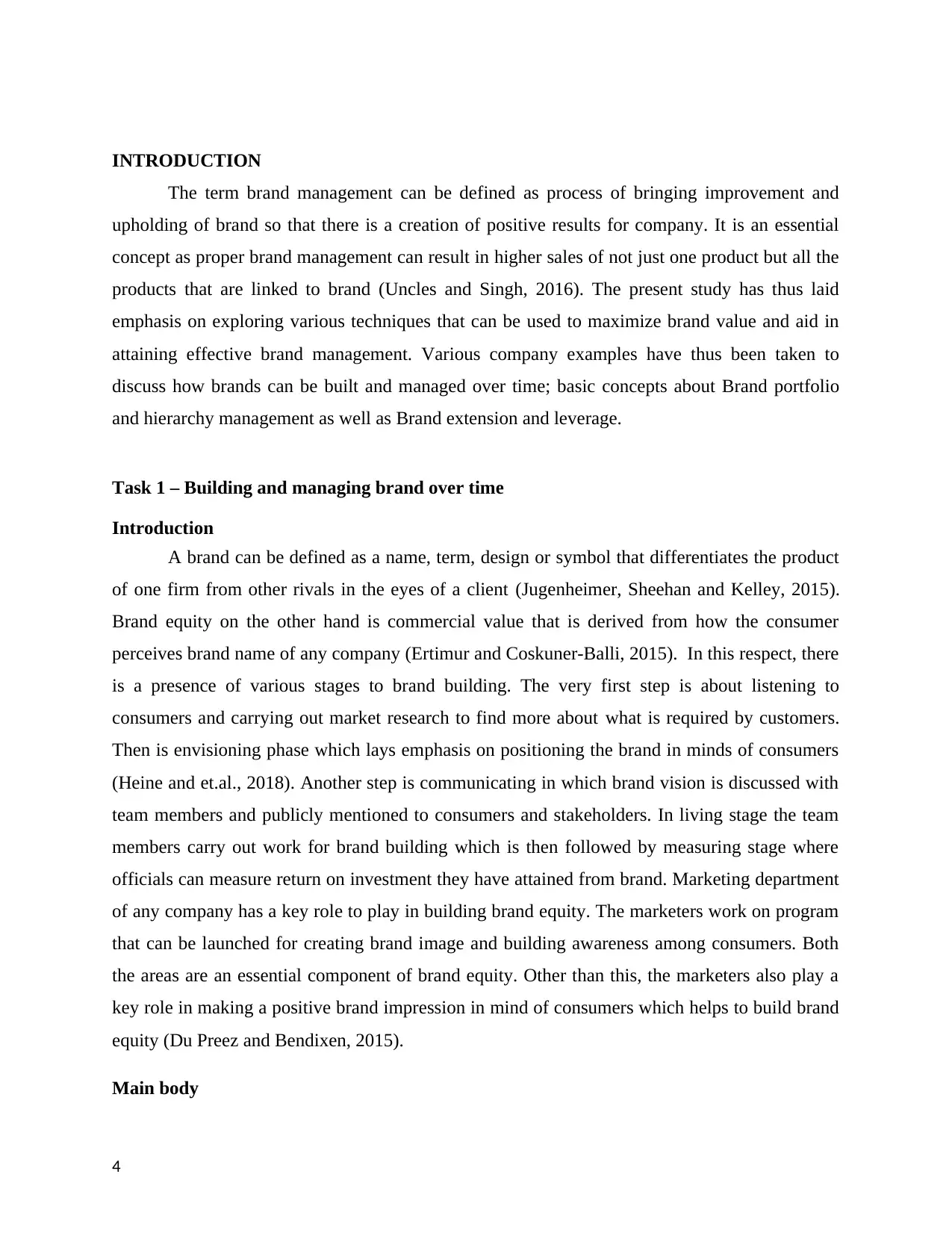
INTRODUCTION
The term brand management can be defined as process of bringing improvement and
upholding of brand so that there is a creation of positive results for company. It is an essential
concept as proper brand management can result in higher sales of not just one product but all the
products that are linked to brand (Uncles and Singh, 2016). The present study has thus laid
emphasis on exploring various techniques that can be used to maximize brand value and aid in
attaining effective brand management. Various company examples have thus been taken to
discuss how brands can be built and managed over time; basic concepts about Brand portfolio
and hierarchy management as well as Brand extension and leverage.
Task 1 – Building and managing brand over time
Introduction
A brand can be defined as a name, term, design or symbol that differentiates the product
of one firm from other rivals in the eyes of a client (Jugenheimer, Sheehan and Kelley, 2015).
Brand equity on the other hand is commercial value that is derived from how the consumer
perceives brand name of any company (Ertimur and Coskuner-Balli, 2015). In this respect, there
is a presence of various stages to brand building. The very first step is about listening to
consumers and carrying out market research to find more about what is required by customers.
Then is envisioning phase which lays emphasis on positioning the brand in minds of consumers
(Heine and et.al., 2018). Another step is communicating in which brand vision is discussed with
team members and publicly mentioned to consumers and stakeholders. In living stage the team
members carry out work for brand building which is then followed by measuring stage where
officials can measure return on investment they have attained from brand. Marketing department
of any company has a key role to play in building brand equity. The marketers work on program
that can be launched for creating brand image and building awareness among consumers. Both
the areas are an essential component of brand equity. Other than this, the marketers also play a
key role in making a positive brand impression in mind of consumers which helps to build brand
equity (Du Preez and Bendixen, 2015).
Main body
4
The term brand management can be defined as process of bringing improvement and
upholding of brand so that there is a creation of positive results for company. It is an essential
concept as proper brand management can result in higher sales of not just one product but all the
products that are linked to brand (Uncles and Singh, 2016). The present study has thus laid
emphasis on exploring various techniques that can be used to maximize brand value and aid in
attaining effective brand management. Various company examples have thus been taken to
discuss how brands can be built and managed over time; basic concepts about Brand portfolio
and hierarchy management as well as Brand extension and leverage.
Task 1 – Building and managing brand over time
Introduction
A brand can be defined as a name, term, design or symbol that differentiates the product
of one firm from other rivals in the eyes of a client (Jugenheimer, Sheehan and Kelley, 2015).
Brand equity on the other hand is commercial value that is derived from how the consumer
perceives brand name of any company (Ertimur and Coskuner-Balli, 2015). In this respect, there
is a presence of various stages to brand building. The very first step is about listening to
consumers and carrying out market research to find more about what is required by customers.
Then is envisioning phase which lays emphasis on positioning the brand in minds of consumers
(Heine and et.al., 2018). Another step is communicating in which brand vision is discussed with
team members and publicly mentioned to consumers and stakeholders. In living stage the team
members carry out work for brand building which is then followed by measuring stage where
officials can measure return on investment they have attained from brand. Marketing department
of any company has a key role to play in building brand equity. The marketers work on program
that can be launched for creating brand image and building awareness among consumers. Both
the areas are an essential component of brand equity. Other than this, the marketers also play a
key role in making a positive brand impression in mind of consumers which helps to build brand
equity (Du Preez and Bendixen, 2015).
Main body
4
Paraphrase This Document
Need a fresh take? Get an instant paraphrase of this document with our AI Paraphraser
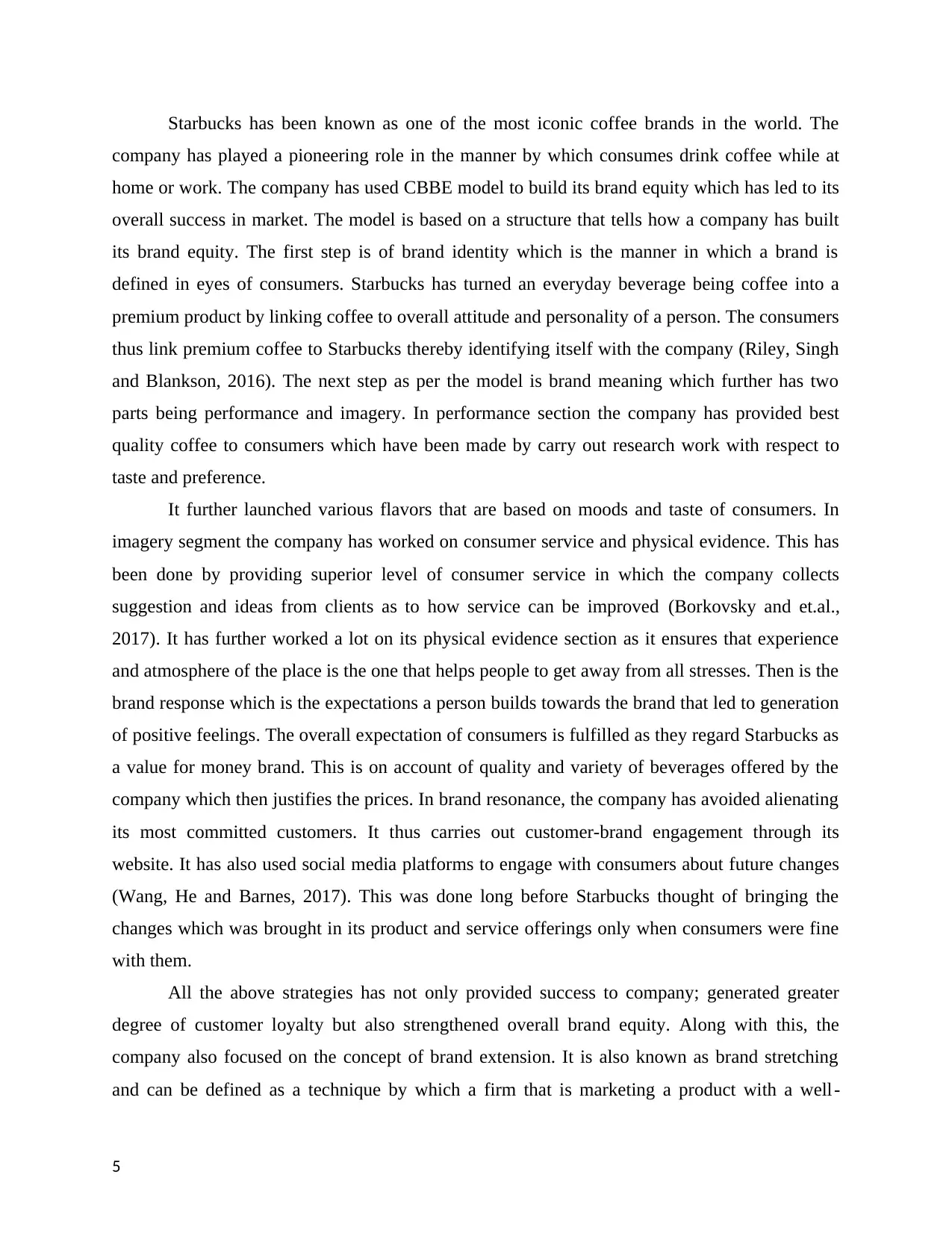
Starbucks has been known as one of the most iconic coffee brands in the world. The
company has played a pioneering role in the manner by which consumes drink coffee while at
home or work. The company has used CBBE model to build its brand equity which has led to its
overall success in market. The model is based on a structure that tells how a company has built
its brand equity. The first step is of brand identity which is the manner in which a brand is
defined in eyes of consumers. Starbucks has turned an everyday beverage being coffee into a
premium product by linking coffee to overall attitude and personality of a person. The consumers
thus link premium coffee to Starbucks thereby identifying itself with the company (Riley, Singh
and Blankson, 2016). The next step as per the model is brand meaning which further has two
parts being performance and imagery. In performance section the company has provided best
quality coffee to consumers which have been made by carry out research work with respect to
taste and preference.
It further launched various flavors that are based on moods and taste of consumers. In
imagery segment the company has worked on consumer service and physical evidence. This has
been done by providing superior level of consumer service in which the company collects
suggestion and ideas from clients as to how service can be improved (Borkovsky and et.al.,
2017). It has further worked a lot on its physical evidence section as it ensures that experience
and atmosphere of the place is the one that helps people to get away from all stresses. Then is the
brand response which is the expectations a person builds towards the brand that led to generation
of positive feelings. The overall expectation of consumers is fulfilled as they regard Starbucks as
a value for money brand. This is on account of quality and variety of beverages offered by the
company which then justifies the prices. In brand resonance, the company has avoided alienating
its most committed customers. It thus carries out customer-brand engagement through its
website. It has also used social media platforms to engage with consumers about future changes
(Wang, He and Barnes, 2017). This was done long before Starbucks thought of bringing the
changes which was brought in its product and service offerings only when consumers were fine
with them.
All the above strategies has not only provided success to company; generated greater
degree of customer loyalty but also strengthened overall brand equity. Along with this, the
company also focused on the concept of brand extension. It is also known as brand stretching
and can be defined as a technique by which a firm that is marketing a product with a well-
5
company has played a pioneering role in the manner by which consumes drink coffee while at
home or work. The company has used CBBE model to build its brand equity which has led to its
overall success in market. The model is based on a structure that tells how a company has built
its brand equity. The first step is of brand identity which is the manner in which a brand is
defined in eyes of consumers. Starbucks has turned an everyday beverage being coffee into a
premium product by linking coffee to overall attitude and personality of a person. The consumers
thus link premium coffee to Starbucks thereby identifying itself with the company (Riley, Singh
and Blankson, 2016). The next step as per the model is brand meaning which further has two
parts being performance and imagery. In performance section the company has provided best
quality coffee to consumers which have been made by carry out research work with respect to
taste and preference.
It further launched various flavors that are based on moods and taste of consumers. In
imagery segment the company has worked on consumer service and physical evidence. This has
been done by providing superior level of consumer service in which the company collects
suggestion and ideas from clients as to how service can be improved (Borkovsky and et.al.,
2017). It has further worked a lot on its physical evidence section as it ensures that experience
and atmosphere of the place is the one that helps people to get away from all stresses. Then is the
brand response which is the expectations a person builds towards the brand that led to generation
of positive feelings. The overall expectation of consumers is fulfilled as they regard Starbucks as
a value for money brand. This is on account of quality and variety of beverages offered by the
company which then justifies the prices. In brand resonance, the company has avoided alienating
its most committed customers. It thus carries out customer-brand engagement through its
website. It has also used social media platforms to engage with consumers about future changes
(Wang, He and Barnes, 2017). This was done long before Starbucks thought of bringing the
changes which was brought in its product and service offerings only when consumers were fine
with them.
All the above strategies has not only provided success to company; generated greater
degree of customer loyalty but also strengthened overall brand equity. Along with this, the
company also focused on the concept of brand extension. It is also known as brand stretching
and can be defined as a technique by which a firm that is marketing a product with a well-
5
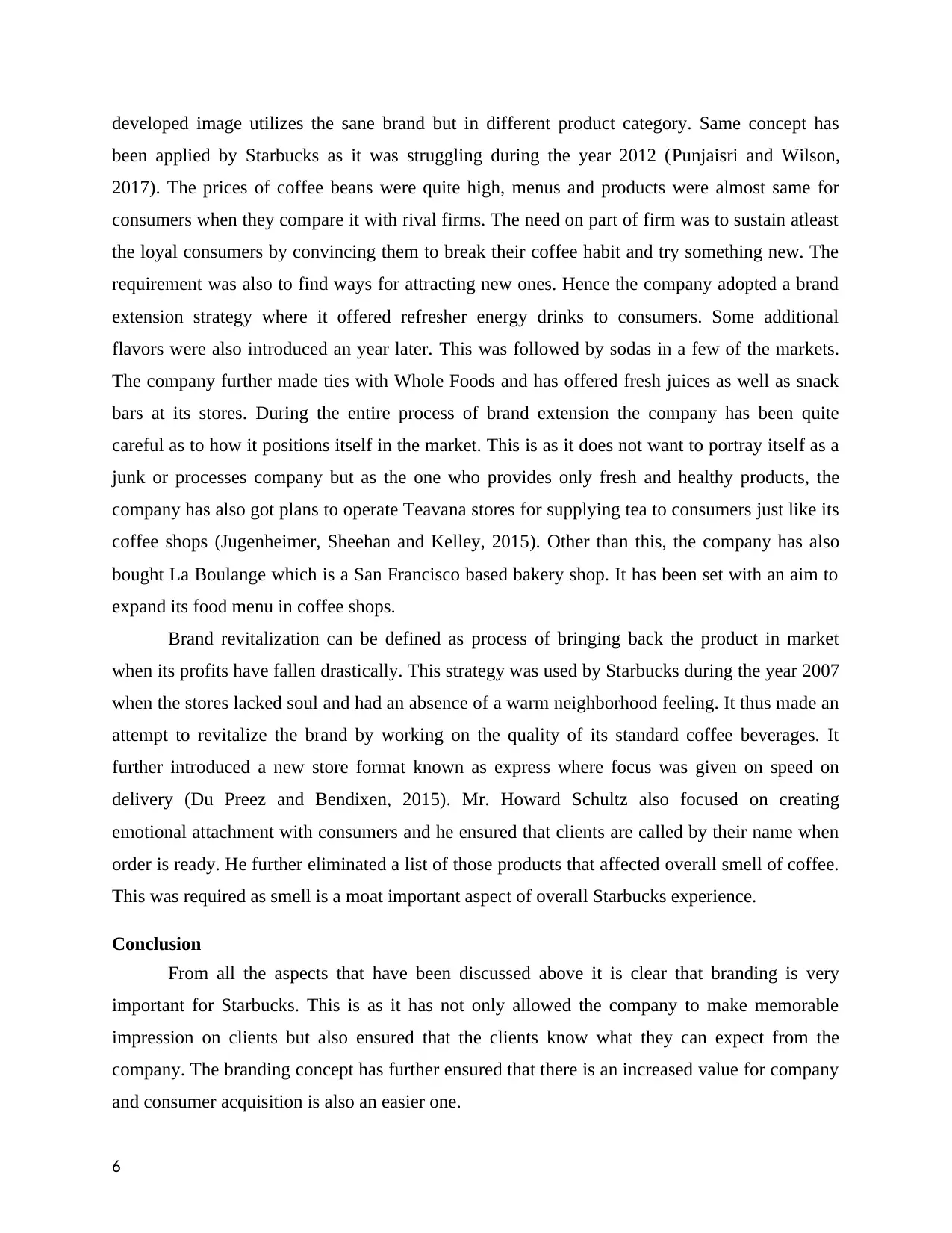
developed image utilizes the sane brand but in different product category. Same concept has
been applied by Starbucks as it was struggling during the year 2012 (Punjaisri and Wilson,
2017). The prices of coffee beans were quite high, menus and products were almost same for
consumers when they compare it with rival firms. The need on part of firm was to sustain atleast
the loyal consumers by convincing them to break their coffee habit and try something new. The
requirement was also to find ways for attracting new ones. Hence the company adopted a brand
extension strategy where it offered refresher energy drinks to consumers. Some additional
flavors were also introduced an year later. This was followed by sodas in a few of the markets.
The company further made ties with Whole Foods and has offered fresh juices as well as snack
bars at its stores. During the entire process of brand extension the company has been quite
careful as to how it positions itself in the market. This is as it does not want to portray itself as a
junk or processes company but as the one who provides only fresh and healthy products, the
company has also got plans to operate Teavana stores for supplying tea to consumers just like its
coffee shops (Jugenheimer, Sheehan and Kelley, 2015). Other than this, the company has also
bought La Boulange which is a San Francisco based bakery shop. It has been set with an aim to
expand its food menu in coffee shops.
Brand revitalization can be defined as process of bringing back the product in market
when its profits have fallen drastically. This strategy was used by Starbucks during the year 2007
when the stores lacked soul and had an absence of a warm neighborhood feeling. It thus made an
attempt to revitalize the brand by working on the quality of its standard coffee beverages. It
further introduced a new store format known as express where focus was given on speed on
delivery (Du Preez and Bendixen, 2015). Mr. Howard Schultz also focused on creating
emotional attachment with consumers and he ensured that clients are called by their name when
order is ready. He further eliminated a list of those products that affected overall smell of coffee.
This was required as smell is a moat important aspect of overall Starbucks experience.
Conclusion
From all the aspects that have been discussed above it is clear that branding is very
important for Starbucks. This is as it has not only allowed the company to make memorable
impression on clients but also ensured that the clients know what they can expect from the
company. The branding concept has further ensured that there is an increased value for company
and consumer acquisition is also an easier one.
6
been applied by Starbucks as it was struggling during the year 2012 (Punjaisri and Wilson,
2017). The prices of coffee beans were quite high, menus and products were almost same for
consumers when they compare it with rival firms. The need on part of firm was to sustain atleast
the loyal consumers by convincing them to break their coffee habit and try something new. The
requirement was also to find ways for attracting new ones. Hence the company adopted a brand
extension strategy where it offered refresher energy drinks to consumers. Some additional
flavors were also introduced an year later. This was followed by sodas in a few of the markets.
The company further made ties with Whole Foods and has offered fresh juices as well as snack
bars at its stores. During the entire process of brand extension the company has been quite
careful as to how it positions itself in the market. This is as it does not want to portray itself as a
junk or processes company but as the one who provides only fresh and healthy products, the
company has also got plans to operate Teavana stores for supplying tea to consumers just like its
coffee shops (Jugenheimer, Sheehan and Kelley, 2015). Other than this, the company has also
bought La Boulange which is a San Francisco based bakery shop. It has been set with an aim to
expand its food menu in coffee shops.
Brand revitalization can be defined as process of bringing back the product in market
when its profits have fallen drastically. This strategy was used by Starbucks during the year 2007
when the stores lacked soul and had an absence of a warm neighborhood feeling. It thus made an
attempt to revitalize the brand by working on the quality of its standard coffee beverages. It
further introduced a new store format known as express where focus was given on speed on
delivery (Du Preez and Bendixen, 2015). Mr. Howard Schultz also focused on creating
emotional attachment with consumers and he ensured that clients are called by their name when
order is ready. He further eliminated a list of those products that affected overall smell of coffee.
This was required as smell is a moat important aspect of overall Starbucks experience.
Conclusion
From all the aspects that have been discussed above it is clear that branding is very
important for Starbucks. This is as it has not only allowed the company to make memorable
impression on clients but also ensured that the clients know what they can expect from the
company. The branding concept has further ensured that there is an increased value for company
and consumer acquisition is also an easier one.
6
⊘ This is a preview!⊘
Do you want full access?
Subscribe today to unlock all pages.

Trusted by 1+ million students worldwide
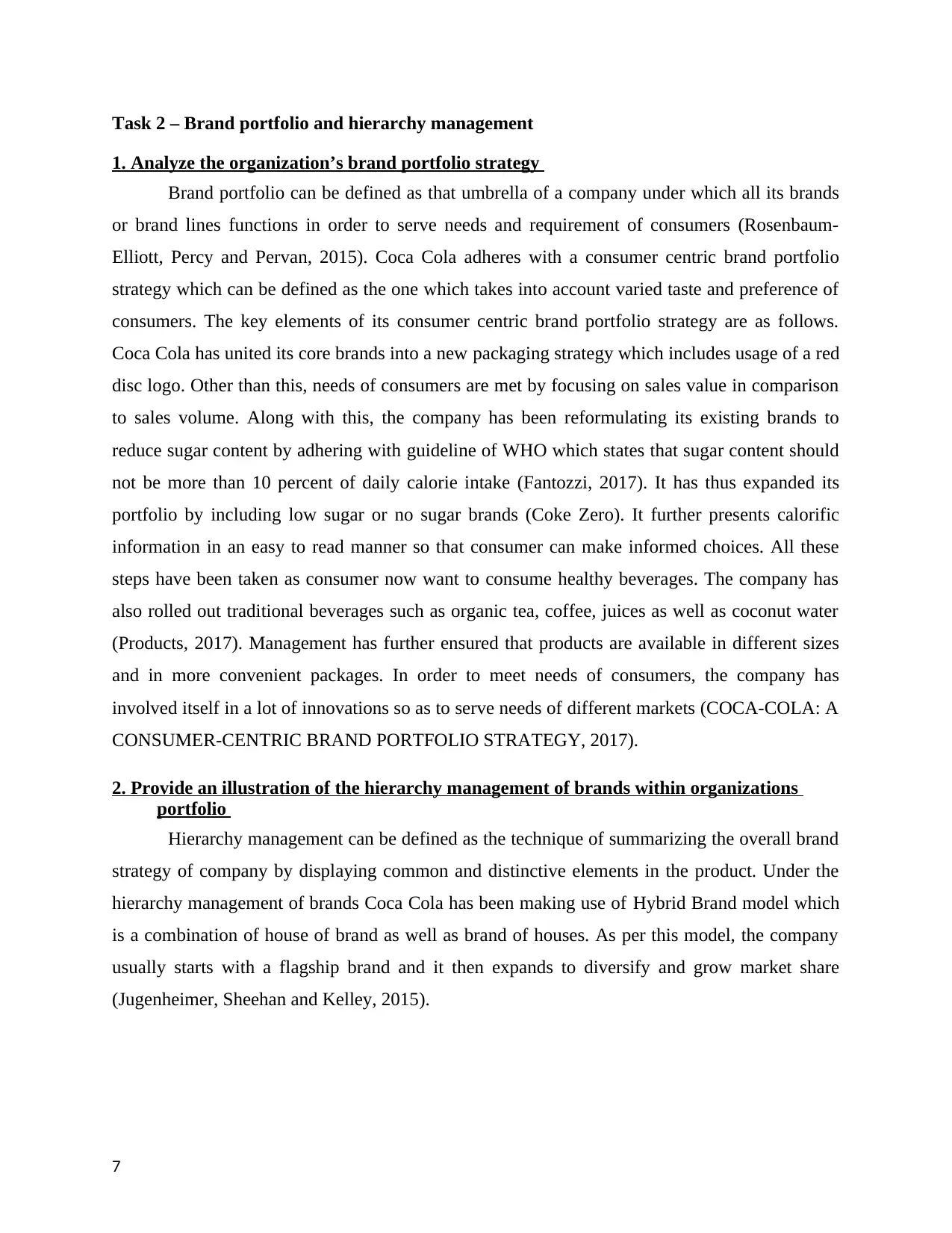
Task 2 – Brand portfolio and hierarchy management
1. Analyze the organization’s brand portfolio strategy
Brand portfolio can be defined as that umbrella of a company under which all its brands
or brand lines functions in order to serve needs and requirement of consumers (Rosenbaum-
Elliott, Percy and Pervan, 2015). Coca Cola adheres with a consumer centric brand portfolio
strategy which can be defined as the one which takes into account varied taste and preference of
consumers. The key elements of its consumer centric brand portfolio strategy are as follows.
Coca Cola has united its core brands into a new packaging strategy which includes usage of a red
disc logo. Other than this, needs of consumers are met by focusing on sales value in comparison
to sales volume. Along with this, the company has been reformulating its existing brands to
reduce sugar content by adhering with guideline of WHO which states that sugar content should
not be more than 10 percent of daily calorie intake (Fantozzi, 2017). It has thus expanded its
portfolio by including low sugar or no sugar brands (Coke Zero). It further presents calorific
information in an easy to read manner so that consumer can make informed choices. All these
steps have been taken as consumer now want to consume healthy beverages. The company has
also rolled out traditional beverages such as organic tea, coffee, juices as well as coconut water
(Products, 2017). Management has further ensured that products are available in different sizes
and in more convenient packages. In order to meet needs of consumers, the company has
involved itself in a lot of innovations so as to serve needs of different markets (COCA-COLA: A
CONSUMER-CENTRIC BRAND PORTFOLIO STRATEGY, 2017).
2. Provide an illustration of the hierarchy management of brands within organizations
portfolio
Hierarchy management can be defined as the technique of summarizing the overall brand
strategy of company by displaying common and distinctive elements in the product. Under the
hierarchy management of brands Coca Cola has been making use of Hybrid Brand model which
is a combination of house of brand as well as brand of houses. As per this model, the company
usually starts with a flagship brand and it then expands to diversify and grow market share
(Jugenheimer, Sheehan and Kelley, 2015).
7
1. Analyze the organization’s brand portfolio strategy
Brand portfolio can be defined as that umbrella of a company under which all its brands
or brand lines functions in order to serve needs and requirement of consumers (Rosenbaum-
Elliott, Percy and Pervan, 2015). Coca Cola adheres with a consumer centric brand portfolio
strategy which can be defined as the one which takes into account varied taste and preference of
consumers. The key elements of its consumer centric brand portfolio strategy are as follows.
Coca Cola has united its core brands into a new packaging strategy which includes usage of a red
disc logo. Other than this, needs of consumers are met by focusing on sales value in comparison
to sales volume. Along with this, the company has been reformulating its existing brands to
reduce sugar content by adhering with guideline of WHO which states that sugar content should
not be more than 10 percent of daily calorie intake (Fantozzi, 2017). It has thus expanded its
portfolio by including low sugar or no sugar brands (Coke Zero). It further presents calorific
information in an easy to read manner so that consumer can make informed choices. All these
steps have been taken as consumer now want to consume healthy beverages. The company has
also rolled out traditional beverages such as organic tea, coffee, juices as well as coconut water
(Products, 2017). Management has further ensured that products are available in different sizes
and in more convenient packages. In order to meet needs of consumers, the company has
involved itself in a lot of innovations so as to serve needs of different markets (COCA-COLA: A
CONSUMER-CENTRIC BRAND PORTFOLIO STRATEGY, 2017).
2. Provide an illustration of the hierarchy management of brands within organizations
portfolio
Hierarchy management can be defined as the technique of summarizing the overall brand
strategy of company by displaying common and distinctive elements in the product. Under the
hierarchy management of brands Coca Cola has been making use of Hybrid Brand model which
is a combination of house of brand as well as brand of houses. As per this model, the company
usually starts with a flagship brand and it then expands to diversify and grow market share
(Jugenheimer, Sheehan and Kelley, 2015).
7
Paraphrase This Document
Need a fresh take? Get an instant paraphrase of this document with our AI Paraphraser
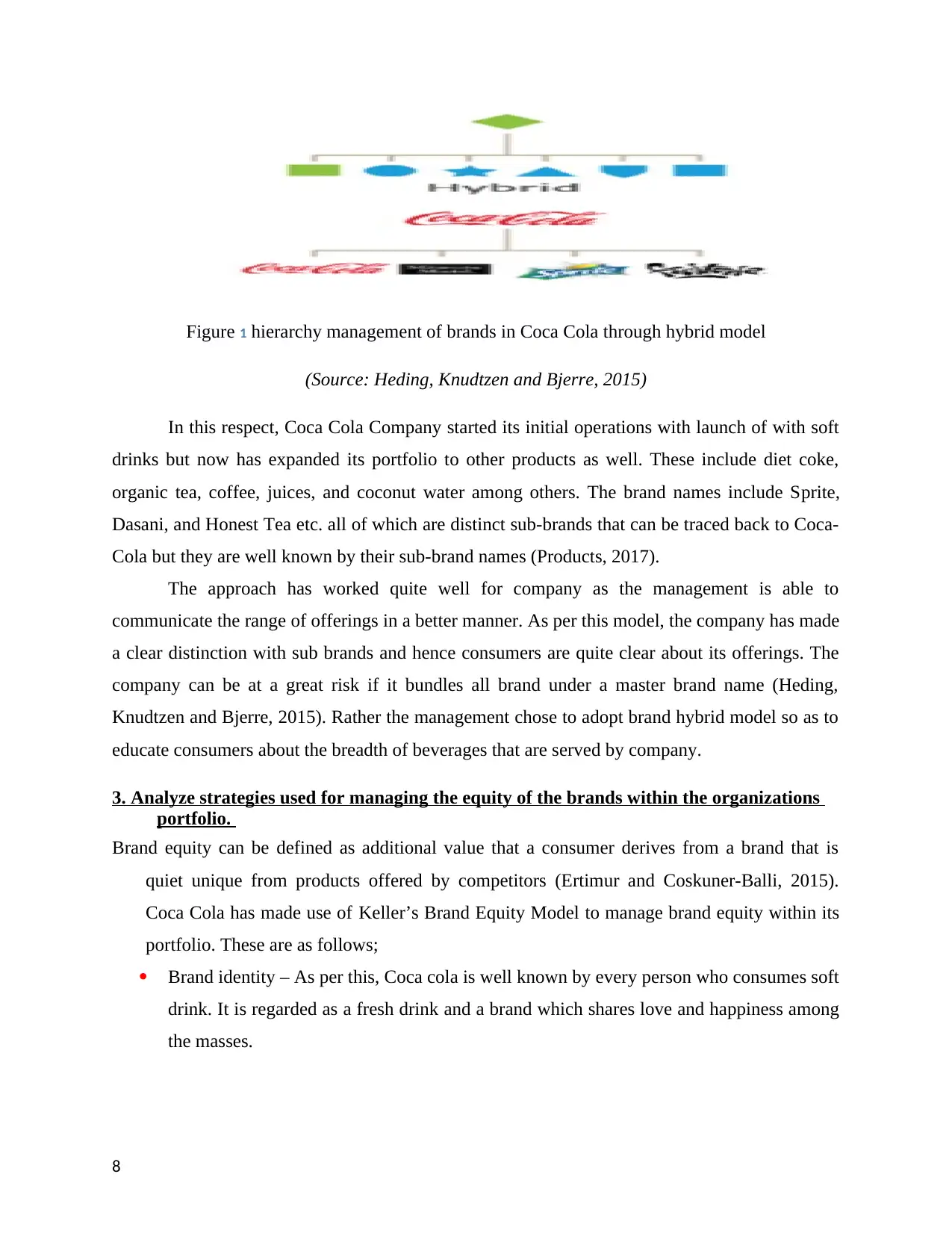
Figure 1 hierarchy management of brands in Coca Cola through hybrid model
(Source: Heding, Knudtzen and Bjerre, 2015)
In this respect, Coca Cola Company started its initial operations with launch of with soft
drinks but now has expanded its portfolio to other products as well. These include diet coke,
organic tea, coffee, juices, and coconut water among others. The brand names include Sprite,
Dasani, and Honest Tea etc. all of which are distinct sub-brands that can be traced back to Coca-
Cola but they are well known by their sub-brand names (Products, 2017).
The approach has worked quite well for company as the management is able to
communicate the range of offerings in a better manner. As per this model, the company has made
a clear distinction with sub brands and hence consumers are quite clear about its offerings. The
company can be at a great risk if it bundles all brand under a master brand name (Heding,
Knudtzen and Bjerre, 2015). Rather the management chose to adopt brand hybrid model so as to
educate consumers about the breadth of beverages that are served by company.
3. Analyze strategies used for managing the equity of the brands within the organizations
portfolio.
Brand equity can be defined as additional value that a consumer derives from a brand that is
quiet unique from products offered by competitors (Ertimur and Coskuner-Balli, 2015).
Coca Cola has made use of Keller’s Brand Equity Model to manage brand equity within its
portfolio. These are as follows;
Brand identity – As per this, Coca cola is well known by every person who consumes soft
drink. It is regarded as a fresh drink and a brand which shares love and happiness among
the masses.
8
(Source: Heding, Knudtzen and Bjerre, 2015)
In this respect, Coca Cola Company started its initial operations with launch of with soft
drinks but now has expanded its portfolio to other products as well. These include diet coke,
organic tea, coffee, juices, and coconut water among others. The brand names include Sprite,
Dasani, and Honest Tea etc. all of which are distinct sub-brands that can be traced back to Coca-
Cola but they are well known by their sub-brand names (Products, 2017).
The approach has worked quite well for company as the management is able to
communicate the range of offerings in a better manner. As per this model, the company has made
a clear distinction with sub brands and hence consumers are quite clear about its offerings. The
company can be at a great risk if it bundles all brand under a master brand name (Heding,
Knudtzen and Bjerre, 2015). Rather the management chose to adopt brand hybrid model so as to
educate consumers about the breadth of beverages that are served by company.
3. Analyze strategies used for managing the equity of the brands within the organizations
portfolio.
Brand equity can be defined as additional value that a consumer derives from a brand that is
quiet unique from products offered by competitors (Ertimur and Coskuner-Balli, 2015).
Coca Cola has made use of Keller’s Brand Equity Model to manage brand equity within its
portfolio. These are as follows;
Brand identity – As per this, Coca cola is well known by every person who consumes soft
drink. It is regarded as a fresh drink and a brand which shares love and happiness among
the masses.
8
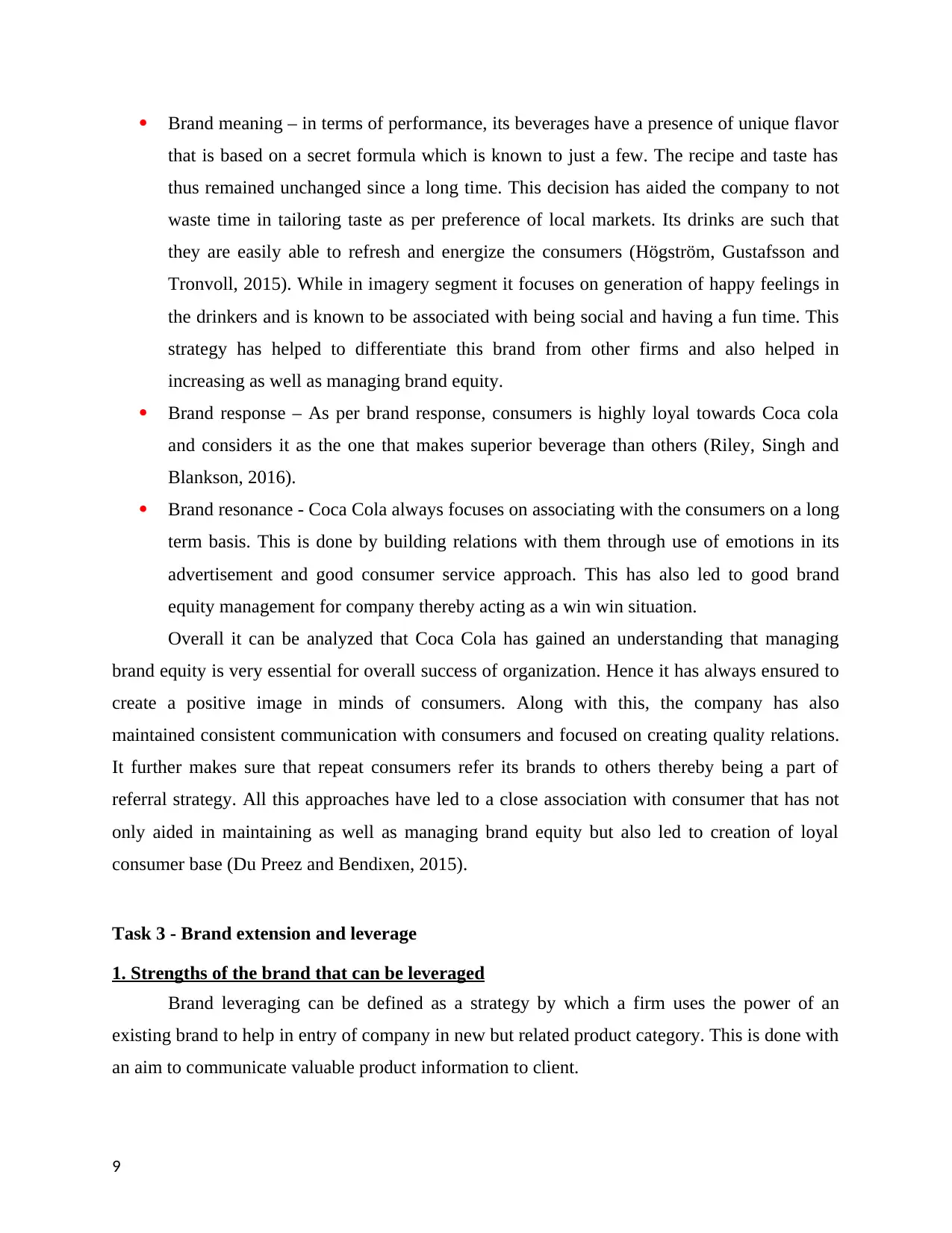
Brand meaning – in terms of performance, its beverages have a presence of unique flavor
that is based on a secret formula which is known to just a few. The recipe and taste has
thus remained unchanged since a long time. This decision has aided the company to not
waste time in tailoring taste as per preference of local markets. Its drinks are such that
they are easily able to refresh and energize the consumers (Högström, Gustafsson and
Tronvoll, 2015). While in imagery segment it focuses on generation of happy feelings in
the drinkers and is known to be associated with being social and having a fun time. This
strategy has helped to differentiate this brand from other firms and also helped in
increasing as well as managing brand equity.
Brand response – As per brand response, consumers is highly loyal towards Coca cola
and considers it as the one that makes superior beverage than others (Riley, Singh and
Blankson, 2016).
Brand resonance - Coca Cola always focuses on associating with the consumers on a long
term basis. This is done by building relations with them through use of emotions in its
advertisement and good consumer service approach. This has also led to good brand
equity management for company thereby acting as a win win situation.
Overall it can be analyzed that Coca Cola has gained an understanding that managing
brand equity is very essential for overall success of organization. Hence it has always ensured to
create a positive image in minds of consumers. Along with this, the company has also
maintained consistent communication with consumers and focused on creating quality relations.
It further makes sure that repeat consumers refer its brands to others thereby being a part of
referral strategy. All this approaches have led to a close association with consumer that has not
only aided in maintaining as well as managing brand equity but also led to creation of loyal
consumer base (Du Preez and Bendixen, 2015).
Task 3 - Brand extension and leverage
1. Strengths of the brand that can be leveraged
Brand leveraging can be defined as a strategy by which a firm uses the power of an
existing brand to help in entry of company in new but related product category. This is done with
an aim to communicate valuable product information to client.
9
that is based on a secret formula which is known to just a few. The recipe and taste has
thus remained unchanged since a long time. This decision has aided the company to not
waste time in tailoring taste as per preference of local markets. Its drinks are such that
they are easily able to refresh and energize the consumers (Högström, Gustafsson and
Tronvoll, 2015). While in imagery segment it focuses on generation of happy feelings in
the drinkers and is known to be associated with being social and having a fun time. This
strategy has helped to differentiate this brand from other firms and also helped in
increasing as well as managing brand equity.
Brand response – As per brand response, consumers is highly loyal towards Coca cola
and considers it as the one that makes superior beverage than others (Riley, Singh and
Blankson, 2016).
Brand resonance - Coca Cola always focuses on associating with the consumers on a long
term basis. This is done by building relations with them through use of emotions in its
advertisement and good consumer service approach. This has also led to good brand
equity management for company thereby acting as a win win situation.
Overall it can be analyzed that Coca Cola has gained an understanding that managing
brand equity is very essential for overall success of organization. Hence it has always ensured to
create a positive image in minds of consumers. Along with this, the company has also
maintained consistent communication with consumers and focused on creating quality relations.
It further makes sure that repeat consumers refer its brands to others thereby being a part of
referral strategy. All this approaches have led to a close association with consumer that has not
only aided in maintaining as well as managing brand equity but also led to creation of loyal
consumer base (Du Preez and Bendixen, 2015).
Task 3 - Brand extension and leverage
1. Strengths of the brand that can be leveraged
Brand leveraging can be defined as a strategy by which a firm uses the power of an
existing brand to help in entry of company in new but related product category. This is done with
an aim to communicate valuable product information to client.
9
⊘ This is a preview!⊘
Do you want full access?
Subscribe today to unlock all pages.

Trusted by 1+ million students worldwide
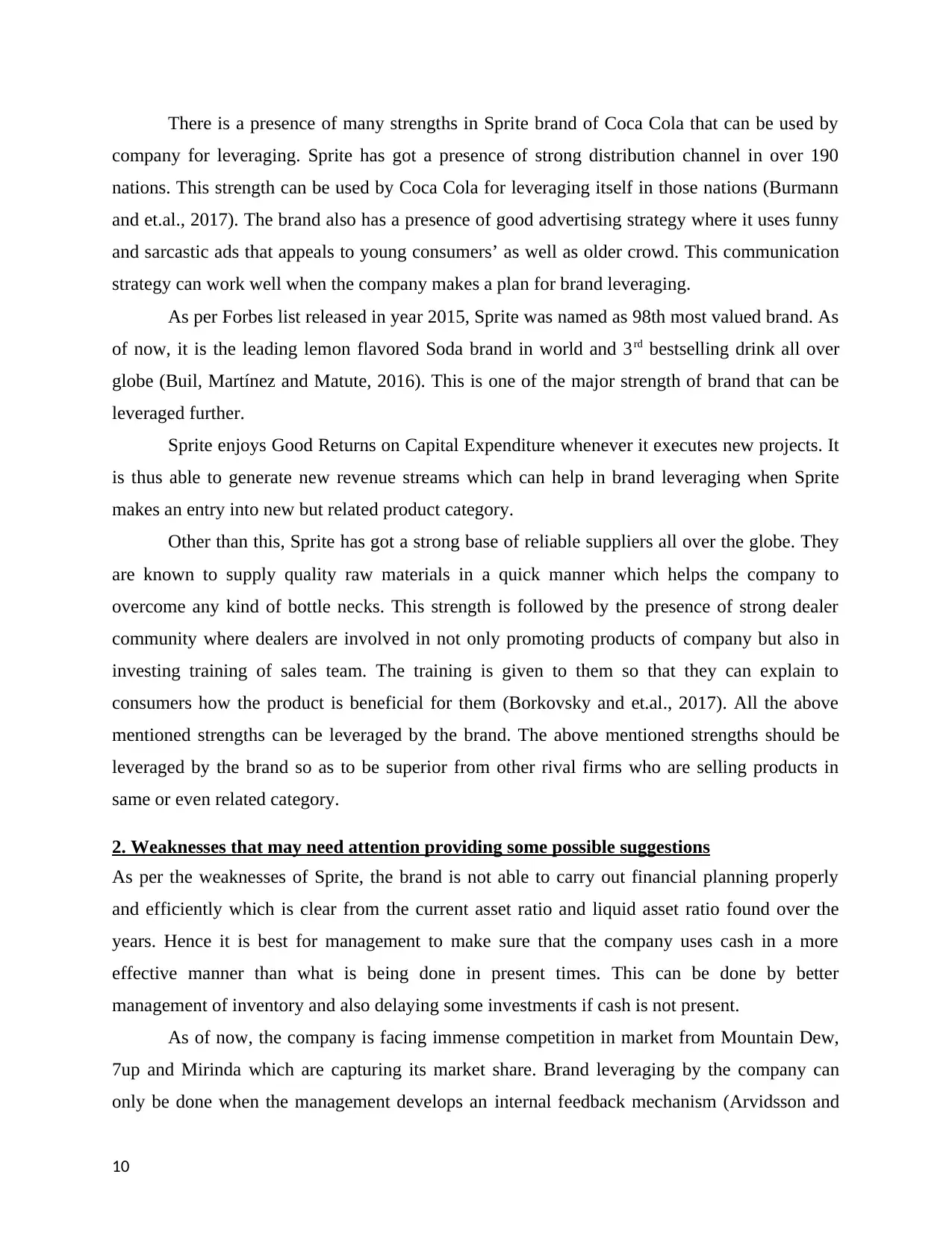
There is a presence of many strengths in Sprite brand of Coca Cola that can be used by
company for leveraging. Sprite has got a presence of strong distribution channel in over 190
nations. This strength can be used by Coca Cola for leveraging itself in those nations (Burmann
and et.al., 2017). The brand also has a presence of good advertising strategy where it uses funny
and sarcastic ads that appeals to young consumers’ as well as older crowd. This communication
strategy can work well when the company makes a plan for brand leveraging.
As per Forbes list released in year 2015, Sprite was named as 98th most valued brand. As
of now, it is the leading lemon flavored Soda brand in world and 3rd bestselling drink all over
globe (Buil, Martínez and Matute, 2016). This is one of the major strength of brand that can be
leveraged further.
Sprite enjoys Good Returns on Capital Expenditure whenever it executes new projects. It
is thus able to generate new revenue streams which can help in brand leveraging when Sprite
makes an entry into new but related product category.
Other than this, Sprite has got a strong base of reliable suppliers all over the globe. They
are known to supply quality raw materials in a quick manner which helps the company to
overcome any kind of bottle necks. This strength is followed by the presence of strong dealer
community where dealers are involved in not only promoting products of company but also in
investing training of sales team. The training is given to them so that they can explain to
consumers how the product is beneficial for them (Borkovsky and et.al., 2017). All the above
mentioned strengths can be leveraged by the brand. The above mentioned strengths should be
leveraged by the brand so as to be superior from other rival firms who are selling products in
same or even related category.
2. Weaknesses that may need attention providing some possible suggestions
As per the weaknesses of Sprite, the brand is not able to carry out financial planning properly
and efficiently which is clear from the current asset ratio and liquid asset ratio found over the
years. Hence it is best for management to make sure that the company uses cash in a more
effective manner than what is being done in present times. This can be done by better
management of inventory and also delaying some investments if cash is not present.
As of now, the company is facing immense competition in market from Mountain Dew,
7up and Mirinda which are capturing its market share. Brand leveraging by the company can
only be done when the management develops an internal feedback mechanism (Arvidsson and
10
company for leveraging. Sprite has got a presence of strong distribution channel in over 190
nations. This strength can be used by Coca Cola for leveraging itself in those nations (Burmann
and et.al., 2017). The brand also has a presence of good advertising strategy where it uses funny
and sarcastic ads that appeals to young consumers’ as well as older crowd. This communication
strategy can work well when the company makes a plan for brand leveraging.
As per Forbes list released in year 2015, Sprite was named as 98th most valued brand. As
of now, it is the leading lemon flavored Soda brand in world and 3rd bestselling drink all over
globe (Buil, Martínez and Matute, 2016). This is one of the major strength of brand that can be
leveraged further.
Sprite enjoys Good Returns on Capital Expenditure whenever it executes new projects. It
is thus able to generate new revenue streams which can help in brand leveraging when Sprite
makes an entry into new but related product category.
Other than this, Sprite has got a strong base of reliable suppliers all over the globe. They
are known to supply quality raw materials in a quick manner which helps the company to
overcome any kind of bottle necks. This strength is followed by the presence of strong dealer
community where dealers are involved in not only promoting products of company but also in
investing training of sales team. The training is given to them so that they can explain to
consumers how the product is beneficial for them (Borkovsky and et.al., 2017). All the above
mentioned strengths can be leveraged by the brand. The above mentioned strengths should be
leveraged by the brand so as to be superior from other rival firms who are selling products in
same or even related category.
2. Weaknesses that may need attention providing some possible suggestions
As per the weaknesses of Sprite, the brand is not able to carry out financial planning properly
and efficiently which is clear from the current asset ratio and liquid asset ratio found over the
years. Hence it is best for management to make sure that the company uses cash in a more
effective manner than what is being done in present times. This can be done by better
management of inventory and also delaying some investments if cash is not present.
As of now, the company is facing immense competition in market from Mountain Dew,
7up and Mirinda which are capturing its market share. Brand leveraging by the company can
only be done when the management develops an internal feedback mechanism (Arvidsson and
10
Paraphrase This Document
Need a fresh take? Get an instant paraphrase of this document with our AI Paraphraser
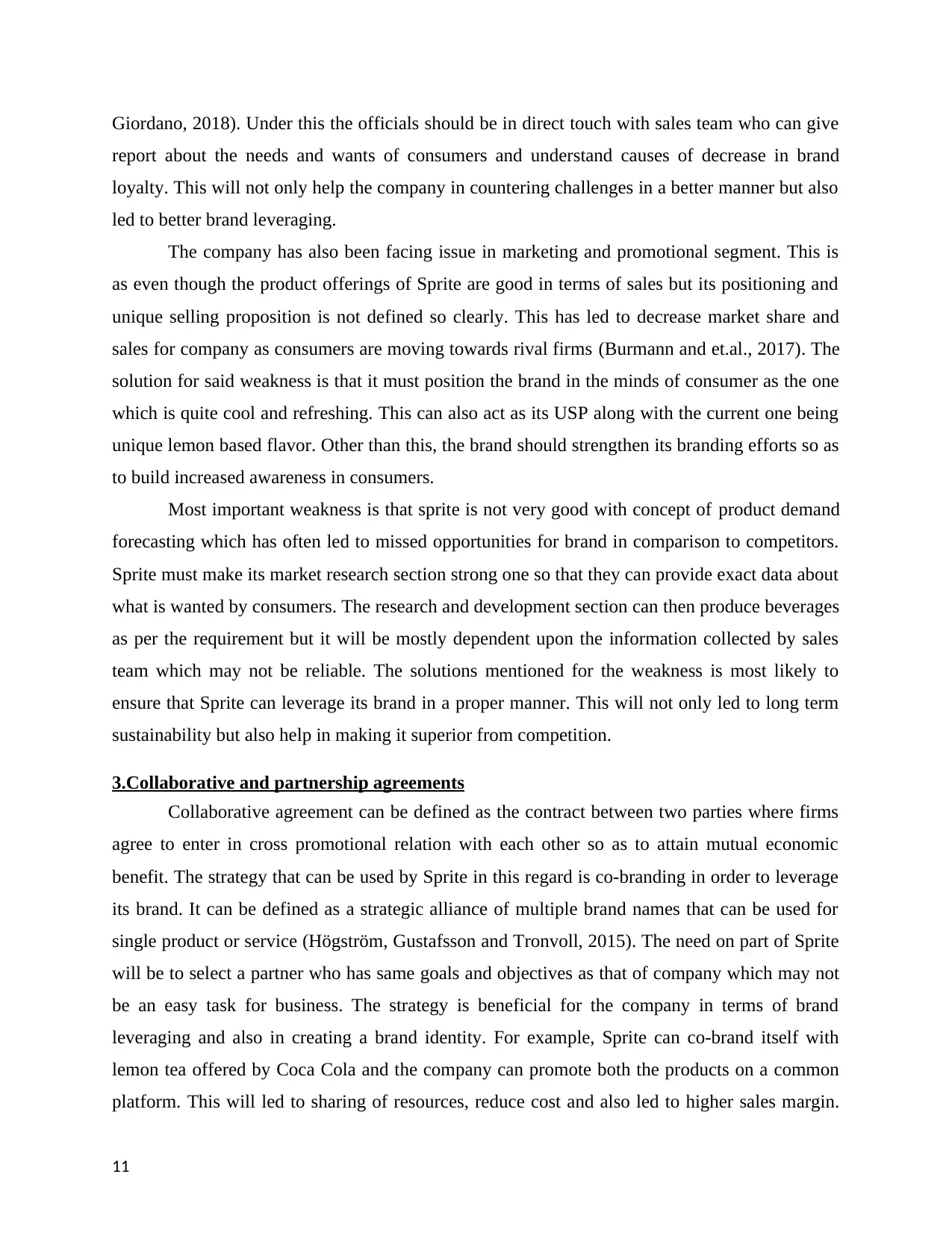
Giordano, 2018). Under this the officials should be in direct touch with sales team who can give
report about the needs and wants of consumers and understand causes of decrease in brand
loyalty. This will not only help the company in countering challenges in a better manner but also
led to better brand leveraging.
The company has also been facing issue in marketing and promotional segment. This is
as even though the product offerings of Sprite are good in terms of sales but its positioning and
unique selling proposition is not defined so clearly. This has led to decrease market share and
sales for company as consumers are moving towards rival firms (Burmann and et.al., 2017). The
solution for said weakness is that it must position the brand in the minds of consumer as the one
which is quite cool and refreshing. This can also act as its USP along with the current one being
unique lemon based flavor. Other than this, the brand should strengthen its branding efforts so as
to build increased awareness in consumers.
Most important weakness is that sprite is not very good with concept of product demand
forecasting which has often led to missed opportunities for brand in comparison to competitors.
Sprite must make its market research section strong one so that they can provide exact data about
what is wanted by consumers. The research and development section can then produce beverages
as per the requirement but it will be mostly dependent upon the information collected by sales
team which may not be reliable. The solutions mentioned for the weakness is most likely to
ensure that Sprite can leverage its brand in a proper manner. This will not only led to long term
sustainability but also help in making it superior from competition.
3.Collaborative and partnership agreements
Collaborative agreement can be defined as the contract between two parties where firms
agree to enter in cross promotional relation with each other so as to attain mutual economic
benefit. The strategy that can be used by Sprite in this regard is co-branding in order to leverage
its brand. It can be defined as a strategic alliance of multiple brand names that can be used for
single product or service (Högström, Gustafsson and Tronvoll, 2015). The need on part of Sprite
will be to select a partner who has same goals and objectives as that of company which may not
be an easy task for business. The strategy is beneficial for the company in terms of brand
leveraging and also in creating a brand identity. For example, Sprite can co-brand itself with
lemon tea offered by Coca Cola and the company can promote both the products on a common
platform. This will led to sharing of resources, reduce cost and also led to higher sales margin.
11
report about the needs and wants of consumers and understand causes of decrease in brand
loyalty. This will not only help the company in countering challenges in a better manner but also
led to better brand leveraging.
The company has also been facing issue in marketing and promotional segment. This is
as even though the product offerings of Sprite are good in terms of sales but its positioning and
unique selling proposition is not defined so clearly. This has led to decrease market share and
sales for company as consumers are moving towards rival firms (Burmann and et.al., 2017). The
solution for said weakness is that it must position the brand in the minds of consumer as the one
which is quite cool and refreshing. This can also act as its USP along with the current one being
unique lemon based flavor. Other than this, the brand should strengthen its branding efforts so as
to build increased awareness in consumers.
Most important weakness is that sprite is not very good with concept of product demand
forecasting which has often led to missed opportunities for brand in comparison to competitors.
Sprite must make its market research section strong one so that they can provide exact data about
what is wanted by consumers. The research and development section can then produce beverages
as per the requirement but it will be mostly dependent upon the information collected by sales
team which may not be reliable. The solutions mentioned for the weakness is most likely to
ensure that Sprite can leverage its brand in a proper manner. This will not only led to long term
sustainability but also help in making it superior from competition.
3.Collaborative and partnership agreements
Collaborative agreement can be defined as the contract between two parties where firms
agree to enter in cross promotional relation with each other so as to attain mutual economic
benefit. The strategy that can be used by Sprite in this regard is co-branding in order to leverage
its brand. It can be defined as a strategic alliance of multiple brand names that can be used for
single product or service (Högström, Gustafsson and Tronvoll, 2015). The need on part of Sprite
will be to select a partner who has same goals and objectives as that of company which may not
be an easy task for business. The strategy is beneficial for the company in terms of brand
leveraging and also in creating a brand identity. For example, Sprite can co-brand itself with
lemon tea offered by Coca Cola and the company can promote both the products on a common
platform. This will led to sharing of resources, reduce cost and also led to higher sales margin.
11
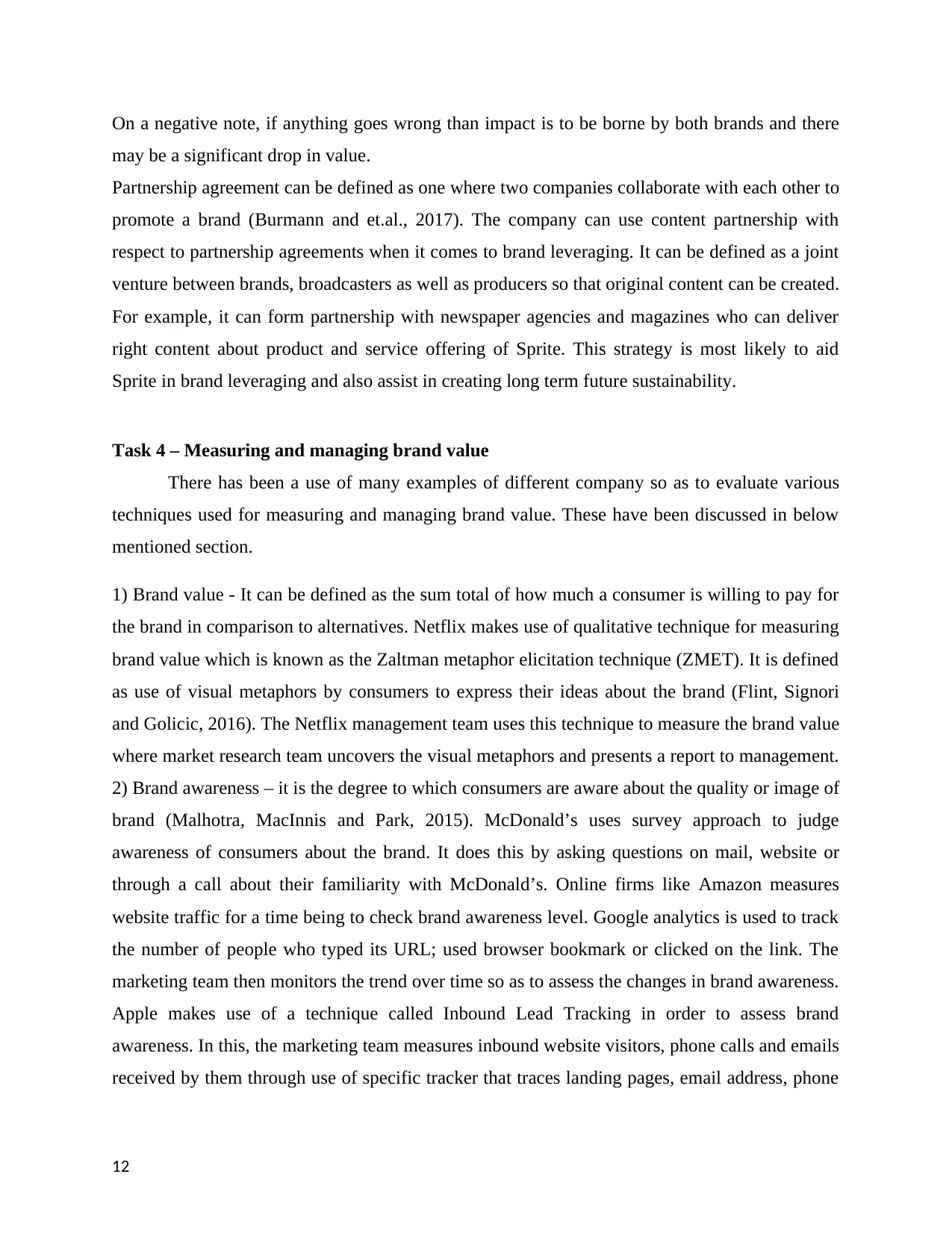
On a negative note, if anything goes wrong than impact is to be borne by both brands and there
may be a significant drop in value.
Partnership agreement can be defined as one where two companies collaborate with each other to
promote a brand (Burmann and et.al., 2017). The company can use content partnership with
respect to partnership agreements when it comes to brand leveraging. It can be defined as a joint
venture between brands, broadcasters as well as producers so that original content can be created.
For example, it can form partnership with newspaper agencies and magazines who can deliver
right content about product and service offering of Sprite. This strategy is most likely to aid
Sprite in brand leveraging and also assist in creating long term future sustainability.
Task 4 – Measuring and managing brand value
There has been a use of many examples of different company so as to evaluate various
techniques used for measuring and managing brand value. These have been discussed in below
mentioned section.
1) Brand value - It can be defined as the sum total of how much a consumer is willing to pay for
the brand in comparison to alternatives. Netflix makes use of qualitative technique for measuring
brand value which is known as the Zaltman metaphor elicitation technique (ZMET). It is defined
as use of visual metaphors by consumers to express their ideas about the brand (Flint, Signori
and Golicic, 2016). The Netflix management team uses this technique to measure the brand value
where market research team uncovers the visual metaphors and presents a report to management.
2) Brand awareness – it is the degree to which consumers are aware about the quality or image of
brand (Malhotra, MacInnis and Park, 2015). McDonald’s uses survey approach to judge
awareness of consumers about the brand. It does this by asking questions on mail, website or
through a call about their familiarity with McDonald’s. Online firms like Amazon measures
website traffic for a time being to check brand awareness level. Google analytics is used to track
the number of people who typed its URL; used browser bookmark or clicked on the link. The
marketing team then monitors the trend over time so as to assess the changes in brand awareness.
Apple makes use of a technique called Inbound Lead Tracking in order to assess brand
awareness. In this, the marketing team measures inbound website visitors, phone calls and emails
received by them through use of specific tracker that traces landing pages, email address, phone
12
may be a significant drop in value.
Partnership agreement can be defined as one where two companies collaborate with each other to
promote a brand (Burmann and et.al., 2017). The company can use content partnership with
respect to partnership agreements when it comes to brand leveraging. It can be defined as a joint
venture between brands, broadcasters as well as producers so that original content can be created.
For example, it can form partnership with newspaper agencies and magazines who can deliver
right content about product and service offering of Sprite. This strategy is most likely to aid
Sprite in brand leveraging and also assist in creating long term future sustainability.
Task 4 – Measuring and managing brand value
There has been a use of many examples of different company so as to evaluate various
techniques used for measuring and managing brand value. These have been discussed in below
mentioned section.
1) Brand value - It can be defined as the sum total of how much a consumer is willing to pay for
the brand in comparison to alternatives. Netflix makes use of qualitative technique for measuring
brand value which is known as the Zaltman metaphor elicitation technique (ZMET). It is defined
as use of visual metaphors by consumers to express their ideas about the brand (Flint, Signori
and Golicic, 2016). The Netflix management team uses this technique to measure the brand value
where market research team uncovers the visual metaphors and presents a report to management.
2) Brand awareness – it is the degree to which consumers are aware about the quality or image of
brand (Malhotra, MacInnis and Park, 2015). McDonald’s uses survey approach to judge
awareness of consumers about the brand. It does this by asking questions on mail, website or
through a call about their familiarity with McDonald’s. Online firms like Amazon measures
website traffic for a time being to check brand awareness level. Google analytics is used to track
the number of people who typed its URL; used browser bookmark or clicked on the link. The
marketing team then monitors the trend over time so as to assess the changes in brand awareness.
Apple makes use of a technique called Inbound Lead Tracking in order to assess brand
awareness. In this, the marketing team measures inbound website visitors, phone calls and emails
received by them through use of specific tracker that traces landing pages, email address, phone
12
⊘ This is a preview!⊘
Do you want full access?
Subscribe today to unlock all pages.

Trusted by 1+ million students worldwide
1 out of 16
Related Documents
Your All-in-One AI-Powered Toolkit for Academic Success.
+13062052269
info@desklib.com
Available 24*7 on WhatsApp / Email
![[object Object]](/_next/static/media/star-bottom.7253800d.svg)
Unlock your academic potential
Copyright © 2020–2025 A2Z Services. All Rights Reserved. Developed and managed by ZUCOL.



